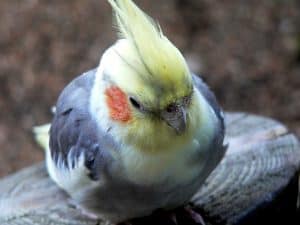Cockatiels and parakeets, is it possible to put these two species together? Parakeets are sociable birds that enjoy being together. The introduction of a new bird, such as the cockatiel, might cause some discomfort among those who were there first, especially if the flock consists of only one or two birds, so you might need to put them in separate cages.

Can Parakeets and Cockatiels Live Together?
Although it might not seem possible, cockatiels and parakeets can live together in the same cage. In fact, cockatiels usually take to other species pretty quickly; so cohabiting with parakeets should be relatively easy. That being said, there are a few precautions you’ll need to take and things you’ll need to do gradually to avoid any changes that could stress your birds out unnecessarily.
How to House Cockatiels and Parakeets Together?
Place the newcomer in quarantine
Each new bird (whether a parakeet or a cockatiel) must go through quarantine to verify that they are healthy and because the birds need time to get acquainted with one another. The new parakeet should be kept in an individual cage near the other birds for the first four weeks. They will thus have an opportunity to get acquainted with each other.
Make the first physical contact
This is a good place to start. Keep it in this configuration until the birds get used to each other. The first physical contact without bars must occur inside the cage where the birds are brought together. If this is their home, make some changes to the interior features and equipment to make it distinctive and non- adversary. If you want your parakeet or cockatiel to eat alone, put bowls on both sides of the cage.
If your birds hiss or puff their wings while you’re away, don’t be alarmed; this is completely natural as long as they don’t act violently. Once the hierarchy is in place, things should calm down. In addition, you may give your birds millet: this treat to eat in groups will help them form a bond and forget their quarrels. If your birds fight a lot, you may need to separate them into different cages and try again a week later. The larger the cage, the easier it will be to establish.
Make sure you have enough space
It is crucial to provide every bird with its own space if you want to house more than two birds together. This allows the bird to escape from noise and activity levels, as well as giving it room to fly and explore all areas of the cage without interruption. Additionally, a place for the bird to retreat is necessary in case another bird becomes bothersome; this can be something like a high perch or box in a quiet corner. All of these factors require extra space, so outdoor aviaries are ideal living conditions for your feathered friends.
Respect the specific dietary needs of both species
Furthermore, you must take into account the varying diets of your birds. Parakeets have their own nutritional needs, just like cockatiels do. All cage dwellers deserve to be content andfed properly. Therefore, you’ll need o keep a keen eye on them so that greedy bird behavior–like one stealing another’s food–doesn’t go unnoticed.
Also, the cockatiel has to eat a lot of oily seeds like sunflower seed. Although an occasional little tasting won’t harm your parakeet, you will need to make sure she does not eat too much and become obese or develop liver problems.
Monitor your birds’ behavior
Parakeets are clever birds, but their cleverness has two sides: it makes them fascinating pets, but also produces each one unique. As a result, a parakeet’s personality will have an impact on the overall cage balance.
What Birds Can Live With Parakeets?

Not only do parakeets get along with other parrot species, other small birds, but they also enjoy the company of cockatiels and lorikeets. Zebra finches are yet another bird that typically gets along well with parakeets.
- STURDY METAL CONSTRUCTION: Constructed of quality wrought steel coated with rust-and water-resistant hammered paint, this divided breeder cage boasts excellent strength and durability, which is ready for your birds to use for years to come.
- FLEXIBLE BREEDING CAGE: The dividing grate helps divide this wide bird cage into two individual breeding/living spaces for housing two or more birds. Each bird cage system contains 2 perches, 2 feeders, a lockable door, a side nesting door, a pull-out tray and a grate. Or you can remove the middle grate to make it a bigger cage.
- STACKABLE FOR MORE VERSATILITY: Got many birds but had limited space to keep them? This stackable breeding cage is your best solution. You can pile up two or three cages together to efficiently leverage the vertical space in the room and save space.
- PET-PARENT FRIENDLY: Four perches and four plastic cups are included for your convenience. The cage has 4 feeding doors on the face for easy seed and water refilling.
- EASY CLEANING: With the waterproof finished cage and the bottom slide-out tray, cleaning for this cage would be a breeze for pet parents. The pull-out grate at the bottom prevents birds from walking in its excrement.
What Birds Can Be Kept With Cockatiels?
Cockatiels are popular pet birds that can sometimes live harmoniously with other bird species. When considering adding another bird to your cockatiel’s environment, it is essential to introduce the birds slowly and ensure they have the proper cage size and bar spacing to prevent overcrowding and injuries.
Bird species that can potentially be kept with cockatiels include both parakeets, such as the budgies and the bourke’s parakeets. It is important to note that not all individual birds will get along with each other, so careful observation and monitoring are necessary during the initial introduction period.
When housing multiple bird species together, always ensure that the cage size is large enough for all birds to have adequate space to move and exercise. A larger cage or even an outdoor aviary is ideal for housing different species together. The cage bar spacing should be appropriate for each bird type, preventing escape or injury from getting stuck between bars.
To minimize territorial disputes and competition for resources, it’s a good idea to provide separate food dishes, dedicated nesting spaces, and multiple perches at varying heights to allow each bird easy access to their preferred resting spots.
In cases where birds do not get along well, having two cages in the same room or an outdoor aviary with separate compartments can provide a safer, more comfortable environment for each bird. This can be especially important for larger birds like parrots or birds that tend to be territorial around food and nesting sites.
It is crucial to always monitor the behavior and interactions of your birds when introducing new species into their living environment. Remember that every bird is unique, and individual personality traits and preferences play a significant role in whether or not they can coexist peacefully with other birds. Address any signs of aggression or stress immediately, and separate the birds if necessary to prevent injury or harm.
In summary, while it is possible to house cockatiels with other bird species such as parakeets, it is essential to introduce the birds slowly, consider the cage size and bar spacing, provide dedicated nesting spaces, and monitor interactions closely to ensure harmonious co-living. Providing each bird with their own food dishes, perches, and separate cages when needed can also help facilitate peaceful interactions between the various species.
Can Parakeets and Cockatiels Eat the Same Food?
Cockatiels can be fed with parakeet food, as long as it has the proper nutritional balance for birds. These birds are from the parrot family and need a similar diet. Parakeets and cockatiels require a seed-based diet, which implies that it is safe for them to consume cockatiel food.
Cockatiels and Parakeets Final Thoughts
The worst-case scenario is for a timid parakeet to live alongside a more dominant cockatiel and if it’s breeding season. In such circumstances, you will have no choice but to intervene because of the general welfare of the cage’s occupants. This is why it’s essential to maintain free flight cage on hand in case cohabitation proves impossible. Keep in mind that these cohabitation difficulties are uncommon in practice, but it’s advisable to be prepared for everything.




